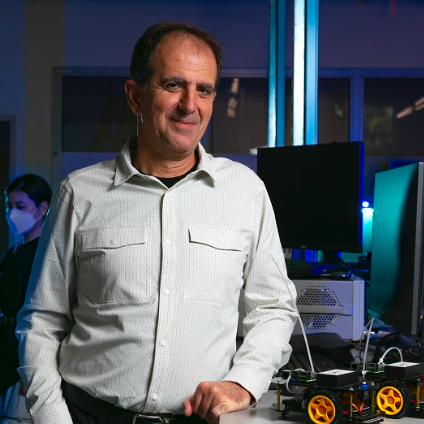

Research Terms
Artificial Intelligence Computer Networks Communications Engineering Electronics Systems Ocean Engineering Information Theory Biology Applied Mathematics Computational Complexity Discrete Mathematics Mathematical Optimization Mathematical Statistics Electronic Equipment and Devices Imaging Technology
Industries
Ocean Microelectronics & Computer Products Software & Computer Systems Design Telecommunications
Center for Connected Autonomy and Artificial Intelligence (CA-AI)
| Director |
Dimitrios Pados |
| Phone | 561-297-2988 |
| Website | http://eng.fau.edu/research/c2a2/ |
| Mission | The mission of the Center is to carry out fundamental and applied research and support workforce development to build future connected autonomous systems and team-AI solutions based on (i) autonomous resilient machine-to-machine wireless communications, (ii) robust team (multi-agent) AI training, and (iii) real-time operational stage monitoring for safety and security. |
Unmanned vehicles in both terrestrial and extraterrestrial environments can be remotely guided and controlled by radio frequency signals. Autonomous vehicles are also frequently equipped with LiDAR (light detection and ranging) technology for mapping, obstacle detection and navigation. In the case of autonomous unmanned underwater vehicles, radio frequency and optical signals do not penetrate far enough into water. Consequently, functionalities that are enabled by radio frequency signals, such as remote control and GPS-based navigation are not available for underwater vehicles. This limitation has led to the use of sound waves for underwater wireless communication and positioning. Acoustic signals can reliably travel long distances through water, but require the use of low frequencies, which in turn, limits available bandwidth.
Researchers at FAU have developed an estimation algorithm that uses acoustic signals with a direction-of-arrival technique for localization. This technology allows for the infrastructure-less 3D self-localization of multiple autonomous underwater vehicles with no reliance on GPS nor on availability of global clock synchronization. The vehicles leverage simple coded beacon signals to self-localize. Self-positioning and automated neighbor discovery of peers in multi-vehicle missions will support position-aware geographic data routing, directional communication links, swarming, collaborative sensing, coordinated sampling and vehicle navigation. The invention has been validated through simulation in statistically modeled underwater acoustic communication channels and water-tank experimentation, which resulted in significantly superior positioning accuracy compared with state-of-the-art estimation techniques.
FAU is seeking partners to advance this technology into the marketplace through licensing or development partnerships.
Airborne Cognitive Networking: Design, Development, and Deployment
Governments and commercial groups are rapidly developing highly sophisticated unmanned undersea vehicles for various applications like deep sea exploration, energy pipelines and defense. While there have been many technological advances, one of the primary challenges is the lack of high-speed and reliable communication components to control and monitor these vehicles.
Researchers at Florida Atlantic University have developed a novel underwater modem offering wideband acoustics, real-time configuration, and wireless communications for underwater vehicles. A prototype of the device has been developed and tested within an underwater environment showing proof of concept using binary frequency shift keying and fast frequency hopping communications protocols.
FAU seeks to advance this innovation into the marketplace through licensing or development partnerships.
A First-of-its-kind Low Size, Weight and Power Run-Time Reconfigurable Underwater Modem



